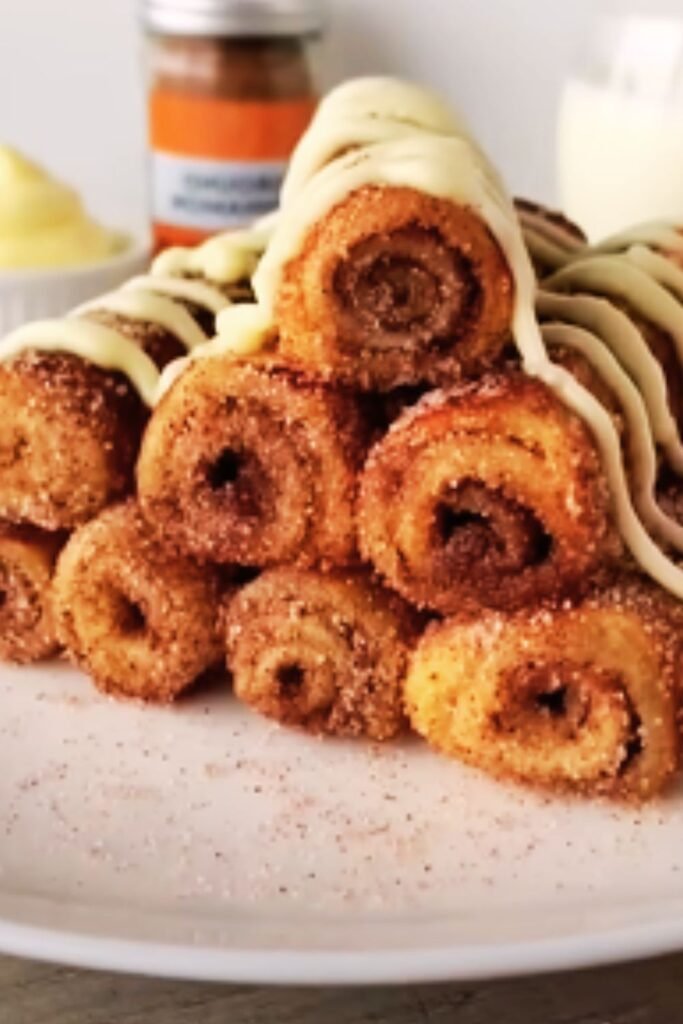There’s nothing that quite compares to the heavenly aroma of freshly baked breakfast rolls wafting through the house on a lazy weekend morning. That warm, yeasty scent has the magical ability to coax even the most dedicated sleep-lovers out of bed. I’ve spent years perfecting my breakfast roll recipes, and today I’m thrilled to share my secrets for creating these morning delights that will transform your breakfast table.
What Makes Breakfast Rolls Special?
Breakfast rolls hold a special place in many cultures around the world. Unlike their lunchtime or dinner counterparts, breakfast rolls often incorporate sweeter elements and warming spices that pair perfectly with morning coffee or tea. They’re designed to be substantial enough to fuel your day but not so heavy that they weigh you down.
I find that the best breakfast rolls strike that perfect balance between pillowy softness and satisfying chew. They should tear apart with ease, revealing a steamy interior that begs for a pat of melting butter or a drizzle of honey.
Essential Ingredients for Perfect Breakfast Rolls
Before diving into specific recipes, let’s explore the key ingredients that create truly exceptional breakfast rolls:
- Flour: The foundation of any good roll. I typically use all-purpose flour, but bread flour will give you a chewier texture with more gluten development.
- Yeast: The magical ingredient that brings life to your dough. Active dry or instant yeast both work well.
- Milk: Creates tender rolls with a soft crumb. I prefer whole milk for richness.
- Butter: Adds flavor and tenderness. Don’t skimp here!
- Eggs: Provide structure, richness, and that beautiful golden color.
- Sugar: Feeds the yeast and adds sweetness. Brown sugar adds a caramel note.
- Salt: Enhances flavors and controls yeast activity.
The Science Behind Perfect Breakfast Rolls
Understanding the science of bread-making has revolutionized my breakfast roll game. Here’s what happens in the process:
Gluten Development : When flour meets liquid and is kneaded, proteins form gluten networks that give your rolls structure and that delightful chew.
Yeast Fermentation : Yeast consumes sugars and produces carbon dioxide gas, which creates bubbles in the dough that make it rise.
Maillard Reaction : This complex chemical reaction between amino acids and reducing sugars creates the beautiful brown crust and deep flavors during baking.
Fat Incorporation : Butter or oil coats the gluten strands, creating tenderness and preventing the rolls from becoming tough.
Classic Cinnamon Breakfast Rolls
Let me share my tried-and-true recipe for cinnamon rolls that has become a weekend tradition in my household.
Ingredients
For the dough:
- 4 cups all-purpose flour
- 1 package (2¼ teaspoons) active dry yeast
- 1 cup warm milk (110°F)
- ⅓ cup granulated sugar
- ⅓ cup unsalted butter, softened
- 1 teaspoon salt
- 2 large eggs, room temperature
For the filling:
- ¾ cup brown sugar, packed
- 2 tablespoons ground cinnamon
- ½ cup unsalted butter, softened
For the cream cheese frosting:
- 4 ounces cream cheese, softened
- ¼ cup unsalted butter, softened
- 1½ cups powdered sugar
- ½ teaspoon vanilla extract
- Pinch of salt
Step-by-Step Instructions
- Activate the yeast: In a small bowl, combine warm milk with 1 tablespoon of the sugar and sprinkle the yeast over the top. Let it sit for 5-10 minutes until foamy.
- Create the dough base: In a large mixing bowl or stand mixer fitted with a dough hook, combine 2 cups of flour, remaining sugar, and salt.
- Add wet ingredients: Add the yeast mixture, softened butter, and eggs to the dry ingredients. Mix until combined.
- Develop the dough: Gradually add remaining flour, ½ cup at a time, until a soft dough forms. It should pull away from the sides of the bowl but still feel slightly tacky.
- Knead: Turn dough onto a floured surface and knead for 5-7 minutes until smooth and elastic. Alternatively, knead with the dough hook for 4-5 minutes.
- First rise: Place dough in a greased bowl, cover with a damp cloth, and let rise in a warm place for about 1 hour, or until doubled in size.
- Prepare the filling: Mix brown sugar and cinnamon together in a small bowl.
- Shape the rolls: On a floured surface, roll the dough into a 16×12 inch rectangle. Spread softened butter over the surface, then sprinkle evenly with the cinnamon-sugar mixture, leaving a ½-inch border along one long edge.
- Roll and cut: Starting from the long edge (without the border), tightly roll the dough into a log. Using a sharp knife or unflavored dental floss, cut into 12 equal rolls.
- Second rise: Place rolls in a greased 9×13 inch baking pan, cover, and let rise for another 30-45 minutes until puffy.
- Bake: Preheat oven to 350°F and bake for 25-30 minutes until golden brown.
- Frost: While rolls are still warm, beat together frosting ingredients until smooth and spread over the rolls.

Savory Herb and Cheese Breakfast Rolls
While sweet rolls often steal the spotlight, these savory herb and cheese rolls offer a delicious alternative that pairs beautifully with eggs and breakfast proteins.
Ingredients
For the dough:
- 4 cups all-purpose flour
- 2¼ teaspoons instant yeast
- 1½ teaspoons salt
- 1 cup warm milk (110°F)
- ¼ cup olive oil
- 1 large egg
- 2 tablespoons honey
For the filling:
- ¼ cup softened butter
- 3 cloves garlic, minced
- 2 tablespoons fresh herbs (rosemary, thyme, chives), finely chopped
- 1½ cups shredded cheese (mix of cheddar and mozzarella)
For the topping:
- 2 tablespoons melted butter
- Flaky sea salt
- Additional fresh herbs
Step-by-Step Instructions
- Mix dry ingredients: Combine flour, yeast, and salt in a large bowl.
- Add wet ingredients: Stir in warm milk, olive oil, egg, and honey until a shaggy dough forms.
- Knead: Turn onto a floured surface and knead for 8-10 minutes until smooth and elastic.
- First rise: Place in a greased bowl, cover, and let rise for 1 hour until doubled.
- Prepare filling: Mix softened butter with minced garlic and chopped herbs.
- Shape the rolls: Roll dough into a 14×10 inch rectangle. Spread with herb butter and sprinkle with shredded cheese.
- Roll and cut: Roll into a tight log and cut into 12 equal pieces.
- Second rise: Place in a greased baking dish, cover, and let rise for 30 minutes.
- Bake: Preheat oven to 375°F and bake for 22-25 minutes until golden.
- Finish: Brush with melted butter and sprinkle with sea salt and fresh herbs while still warm.
Whole Grain Breakfast Rolls with Nuts and Seeds
For those mornings when you want something heartier and more nutritious, these whole grain rolls provide sustained energy and a delightful texture contrast.
Ingredients
For the dough:
- 2 cups whole wheat flour
- 2 cups all-purpose flour
- 2¼ teaspoons active dry yeast
- 1½ cups warm milk (110°F)
- ¼ cup honey
- ¼ cup melted butter
- 1 teaspoon salt
- 1 large egg
For the filling/mix-ins:
- ½ cup chopped walnuts
- ¼ cup pumpkin seeds
- ¼ cup sunflower seeds
- 2 tablespoons flaxseeds
- 2 tablespoons chia seeds
- 1 tablespoon ground cinnamon
- ¼ cup brown sugar
For the topping:
- 1 egg white, beaten
- Mixed seeds for sprinkling
Instructions
- Activate yeast: Combine warm milk, 1 tablespoon honey, and yeast. Let stand for 10 minutes until foamy.
- Mix dough: In a large bowl, combine flours and salt. Add yeast mixture, remaining honey, melted butter, and egg. Mix until a cohesive dough forms.
- Develop dough: Knead for 8-10 minutes until smooth and elastic.
- Add mix-ins: Knead in most of the nuts and seeds (reserve some for topping).
- First rise: Place in a greased bowl, cover, and let rise for 1-1.5 hours until doubled.
- Shape rolls: Divide dough into 12 equal portions and shape into rounds.
- Second rise: Place on a parchment-lined baking sheet, cover, and let rise for 45 minutes.
- Prepare for baking: Brush with beaten egg white and sprinkle with reserved seeds.
- Bake: Preheat oven to 375°F and bake for 20-22 minutes until golden and hollow-sounding when tapped.
Quick No-Yeast Breakfast Rolls
Sometimes, despite our best intentions, we don’t have time for yeast-raised dough. These quick breakfast rolls come to the rescue on those mornings.
Ingredients
- 3 cups all-purpose flour
- 1 tablespoon baking powder
- ½ teaspoon baking soda
- 1 teaspoon salt
- 2 tablespoons sugar
- ½ cup cold butter, cubed
- 1 cup buttermilk
- 1 large egg
- ¼ cup honey (for brushing)
Instructions
- Prepare dry ingredients: Whisk together flour, baking powder, baking soda, salt, and sugar.
- Cut in butter: Using a pastry cutter or your fingers, work the cold butter into the flour mixture until it resembles coarse crumbs.
- Add wet ingredients: Stir in buttermilk and egg just until combined. Do not overmix.
- Shape rolls: Turn onto a floured surface and gently form into a 1-inch thick rectangle. Cut into 12 squares.
- Bake: Place on a parchment-lined baking sheet and bake at 425°F for 12-15 minutes until golden.
- Finish: Brush with honey while still warm.

Troubleshooting Common Breakfast Roll Problems
Even experienced bakers encounter issues now and then. Here are solutions to common problems I’ve faced in my roll-making journey:
| Problem | Possible Cause | Solution |
|---|---|---|
| Rolls didn’t rise | Inactive yeast; too cold environment | Test yeast before using; find a warmer spot for rising |
| Dense, heavy texture | Not enough kneading; too much flour | Knead until dough passes the window pane test; measure flour precisely |
| Rolls too dry | Overbaking; too much flour | Reduce baking time; add liquid 1 tablespoon at a time until dough feels right |
| Rolls too pale | Not enough sugar; too low oven temperature | Add 1-2 tablespoons of sugar to dough; increase oven temperature by 25°F |
| Burnt bottoms but undercooked inside | Oven too hot; rack position too low | Lower oven temperature; move rack to middle position |
| Filling leaks out | Roll not tight enough; too much filling | Roll dough more tightly; reduce filling amount slightly |
| Uneven rising | Inconsistent roll sizes; drafty environment | Cut rolls more precisely; cover during rising |
| Frosting too runny | Ingredients too warm; not enough sugar | Chill ingredients before mixing; add more powdered sugar |
| Frosting too thick | Not enough liquid | Add milk or cream 1 teaspoon at a time |
Make-Ahead Options for Busy Mornings
One of my favorite time-saving strategies is preparing breakfast rolls in advance. Here are three methods I use regularly:
Overnight Refrigeration Method
- Prepare the rolls through the shaping and cutting stage.
- Place cut rolls in your greased baking dish.
- Cover tightly with plastic wrap and refrigerate overnight (8-12 hours).
- In the morning, remove from refrigerator and let stand at room temperature for 30-45 minutes.
- Bake as directed, adding 2-3 minutes to the baking time.
Freezer Method
- Prepare rolls completely through baking, but do not add frosting.
- Cool completely, then wrap tightly in plastic wrap and aluminum foil.
- Freeze for up to 2 months.
- To serve, thaw overnight in the refrigerator, then warm in a 300°F oven for 10-15 minutes.
- Add fresh frosting after warming.
Par-Baked Method
- Prepare and shape rolls as directed.
- Bake for only half the required time (until set but not browned).
- Cool completely, wrap, and refrigerate for up to 2 days.
- To finish, bake at the original temperature for the remaining time until golden brown.
Serving Suggestions
Breakfast rolls deserve to be the centerpiece of a beautiful morning spread. Here are some of my favorite serving ideas:
- Create a breakfast roll board with various spreads (butter, jam, honey, nut butters) and fresh fruits
- Serve savory rolls with a herb-infused scrambled egg casserole
- Pair whole grain rolls with yogurt parfaits for a balanced meal
- Offer a selection of fruit juices or coffee with flavored creamers
- For special occasions, create a breakfast roll tree by arranging frosted rolls on a conical stand

Nutritional Considerations and Adaptations
While traditional breakfast rolls are undeniably delicious, I’ve developed several adaptations to accommodate different dietary needs:
Gluten-Free Adaptation
- Replace all-purpose flour with a high-quality gluten-free flour blend (containing xanthan gum)
- Add 1 tablespoon of psyllium husk powder for better texture
- Increase the liquid by 2-3 tablespoons
- Expect a softer dough that’s more difficult to shape
Dairy-Free Adaptation
- Substitute plant-based milk (oat or almond work well)
- Use coconut oil or plant-based butter alternative
- For frosting, use dairy-free cream cheese alternative and plant-based butter
Lower-Sugar Option
- Reduce sugar in the dough by half
- Use mashed ripe banana or unsweetened applesauce in place of some sugar
- Sprinkle with cinnamon instead of using a sugar-heavy filling
- Top with a light glaze made with powdered sugar and lemon juice instead of frosting
Higher-Protein Version
- Add ¼ cup of unflavored protein powder to the dough
- Incorporate Greek yogurt into the dough (replace ¼ cup of milk)
- Use nuts and seeds generously in fillings
- Serve with a side of Greek yogurt
The Cultural Significance of Breakfast Rolls
Breakfast rolls appear in various forms across different cultures, each with their own special traditions:
- Swedish Kanelbullar: Cinnamon rolls spiced with cardamom and topped with pearl sugar
- German Franzbrötchen: Sweet pastry with cinnamon and sugar, popular in Hamburg
- British Chelsea Buns: Currant-filled spiral buns with a sticky glaze
- American Cinnamon Rolls: Generous size with cream cheese frosting
- Japanese Anpan: Sweet rolls filled with red bean paste
- Eastern European Kolaches: Fruit-filled buns with a depression in the center
I find it fascinating how these similar yet distinct variations reflect local ingredients and cultural preferences. The universal appeal of a warm, freshly baked morning roll transcends borders and brings people together around the breakfast table.
Seasonal Breakfast Roll Variations
One of the joys of breakfast roll baking is adapting recipes to showcase seasonal ingredients:
Spring
- Lemon zest and poppy seed filling
- Strawberry jam swirl
- Fresh herb and goat cheese savory rolls
Summer
- Peach and cinnamon filling
- Blueberry cream cheese rolls
- Basil, tomato, and mozzarella savory rolls
Fall
- Pumpkin dough with maple filling
- Apple and walnut cinnamon rolls
- Sage and butternut squash savory rolls
Winter
- Gingerbread spiced rolls
- Cranberry orange rolls
- Caramelized onion and gruyere savory rolls
Questions & Answers
What’s the secret to super soft breakfast rolls? The key to exceptionally soft rolls is using the tangzhong method, which involves cooking a small portion of the flour and liquid to create a paste before adding it to the dough. This pre-gelatinizes the starches, allowing them to hold more moisture during baking. I also recommend using bread flour for structure while adding fat (like butter or oil) to tenderize the crumb.
Can I make breakfast rolls without a stand mixer? Absolutely! While a stand mixer makes the process easier, I made rolls by hand for years before investing in one. The key is to develop a good kneading technique – press the dough away from you with the heel of your hand, fold it back on itself, rotate a quarter turn, and repeat. You’ll know it’s ready when the dough feels smooth and elastic, and a small piece can be stretched thin enough to see light through it (the windowpane test).
Why did my cinnamon roll filling leak out during baking? This is a common issue with three potential causes: the filling might contain too much butter, the dough wasn’t rolled tightly enough, or the rolls were placed too far apart in the pan. I’ve found that slightly reducing the butter in the filling, ensuring a tight roll, and placing the rolls close together in the baking pan (they should touch each other) prevents most leakage issues.
How can I get evenly sized rolls every time? I swear by the dental floss method: after rolling your dough into a log, take a piece of unflavored dental floss, slide it under the log, cross the ends over the top, and pull—this gives you a clean cut without compressing the dough. For perfectly even sizing, I measure the log’s length and mark it with small indentations before cutting.
Can breakfast rolls be made with sourdough starter instead of commercial yeast? Yes, and they’re delicious! Replace the commercial yeast with 1 cup of active sourdough starter and reduce the flour and liquid in the recipe each by ½ cup. The rising time will be longer—expect 3-4 hours for the first rise and 2-3 hours for the second. The flavor complexity is worth the wait, with tangy notes that balance perfectly with sweet fillings.
What’s the best way to reheat leftover breakfast rolls? For that fresh-baked taste and texture, wrap individual rolls in foil and heat in a 300°F oven for 10-12 minutes. If you’re short on time, microwave a roll for 15-20 seconds with a small cup of water alongside it—the steam helps prevent the roll from becoming tough or dry. Avoid reheating with frosting if possible; it’s best to add fresh frosting after warming.
How do I know when my dough has risen enough? The “poke test” is my foolproof method: gently poke the dough with your fingertip about ½ inch deep. If the indentation remains without springing back, the dough is ready. If it springs back completely, it needs more time. If it collapses, it’s over-proofed—in this case, punch it down, reshape, and give it a shorter second rise.
Why are my rolls sometimes dense instead of fluffy? Dense rolls usually result from insufficient rising, which can happen if your yeast is old, your rising environment is too cold, or you’ve added too much flour. I recommend checking your yeast’s expiration date, finding a warm spot for rising (I use my oven with just the light on), and measuring flour by weight rather than volume for precision.
A Final Note on Breakfast Roll Magic
There’s something deeply satisfying about creating breakfast rolls from scratch. Beyond the delicious results, the process itself—the measuring, mixing, kneading, and shaping—has become a form of mindfulness practice for me. On busy weekdays, pulling a pre-made batch from the freezer brings that same comfort with minimal effort.
Whether you’re a seasoned baker or trying your hand at homemade rolls for the first time, I encourage you to embrace both the science and the art of the process. Follow the recipes as a starting point, but don’t be afraid to experiment with flavors and techniques that appeal to you.
The real magic of breakfast rolls lies not just in their taste but in their ability to transform an ordinary morning into something special. There’s profound joy in watching loved ones gather around the table, drawn by that irresistible aroma, eyes lighting up at the sight of warm, freshly baked rolls. In our fast-paced world, these small moments of connection around good food become increasingly precious.
So heat your oven, dust your countertop with flour, and dive into the rewarding world of breakfast roll baking. Your mornings will never be the same again!


